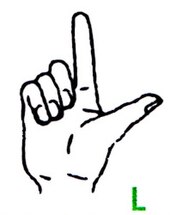L.
L or l (spoken: [ ʔɛl ]) is the eleventh letter of the classical and the twelfth letter of the modern Latin alphabet . It is a consonant in most languages . The letter L has an average frequency of 3.44% in German texts. This makes it the eleventh most common letter in German texts .

The finger alphabet for the deaf and hard of hearing represents the letter L with the palm facing away from the body, the index finger pointing up and the thumb pointing to the left. The remaining fingers are on the palm.
pronunciation
L is a sounding glide or flowing sound (a liquid ), a sonorant and as such is so closely related to the vowels that it can even appear syllable-forming like a vowel , for example in the German word Handel (pronounced handl). In Bavarian it is also written like this: z. B. Seidl . Depending on the position of the tongue, one can distinguish the following:
- The dental or alveolar l is the most common type of l in German and most languages. Like the corresponding r, it is formed simply by placing the tip of the tongue against the back gums of the upper teeth ( tooth sockets ). One can distinguish between a light and a dark oil . A bright l produced by Palatalisierung while a dark l by velarization can be formed.
- The dorsal or mouillate l is formed by bringing the back of the tongue closer to the hard palate and at the same time bending the tip of the tongue down; it emulates a j. This l can be found in Spanish as ll (for example in Melilla or Llano ), in Italian as gl, in Portuguese as lh. In Slavonic this sound corresponds to the soft variant of the sound l .
All types of the "l" have in common that the tip of the tongue blocks the mouth towards the front in the middle, just like when forming the "d" and "t", while the air sweeps sideways along the two cheeks .
In Sanskrit there is a special sign for the vowel l, and l is also used as a vowel in the Czech language .
The special form in Viennese dialect is the Meidlinger L .
origin

|

|

|
|

|
| Ox cutlet (Protosinaitic) | Phoenician Lamed | Greek lambda | Etruscan L | Latin L |
In the Protosinaitic script , the letter represents an ox necklet - a stick with spikes that was used to drive oxen. In the Phoenician alphabet, the Lamed (ox-knuckle), which stood for the sound value [l], developed from this.
In the Greek alphabet , the lamed was adopted as lambda and also had the sound value [l]. At the beginning, the lambda was drawn very similarly to the lamed, as a line with a beginning, up to classical Greek, the roof shape of today's lambda developed from this.
The Etruscans took over the archaic form from the Greeks and continued to use it. This shape was also adopted by the Romans. After the writing direction of Latin changed, the L was oriented to the right, but otherwise retained without changes.
typography
The lowercase l is problematic as a letter because it can easily be confused with other characters. In Sans serif fonts such as Helvetica or Arial , it is similar to the capital i ( I ), but is taller and narrower, which, however, can usually not be displayed or perceived on screens. In typewriter fonts, however, there is a risk of confusion with the one (1). This is particularly virulent when mixing numbers and letters, especially when the small l is used as an abbreviation for liter . It is therefore advisable to use a special literary symbol in the form of a cursive -l (ℓ) or the capital L. On some older typewriters , necessity was made a virtue and the 1 was left out entirely in order to save types; it is replaced by the small l.
After a single or double lowercase f, the lowercase l is often merged into a ligature .
Quote
"... a sound that together with l and the nasal m and n forms the group of liquid (semivocales). It is the more recent modification of the r-sound, which is why we see that it is often an r in the primordial related languages, namely in the European group of the same, a l, partly in the Asiatic members, which here preserved the older aloud corresponds to ... "
Remarks
- ↑ Today it is doubted that the r instead of l in the eastern (in Grimm: "Asian") Indo-European languages reflects the older phonetic level and that the l developed from r in Indo-European. According to Hans Krahe ( Indo-European Linguistics. 6th edition. Walter de Gruyter, Berlin / New York 1985, p. 87) the other way around, the Indo-European l has become r in Old Indian.